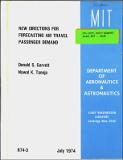New directions for forecasting air travel passenger demand
Author(s)
Garvett, Donald Stephen; Taneja, Nawal K.
DownloadFTL_R_1974_03.pdf (9.781Mb)
Other Contributors
Massachusetts Institute of Technology. Flight Transportation Laboratory
Metadata
Show full item recordAbstract
While few will disagree that sound forecasts are an essential prerequisite to rational transportation planning and analysis, the making of these forecasts has become a complex problem with the broadening of the scope and variety of transportation decisions. Until recently, the forecasting methods available addressed the issues which were important a couple of decades ago. These methods attempted to predict the amount and in some cases character of travel to be used in designing major highways, transit facilities, seaport facilities, and airports. However, today's issues to be addressed in transportation are much broader and more complex. For example, in the modern process of transportation planning, the decision-maker is concerned with the broad range of social, economic and environmental effects, equity issues, wider range of options including not building major facilities, resource constraints such as energy, and increased public participation in the planning process in general. The complexity of the problem has necessitated the planner's developing improved methods of forecasting the demand for transportation at all levels and by all modes. While significant contributions have been made recently to the development of improved methods in forecasting, we are still a long way from possessing tools which provide our decision-makers with more effective, that is, more useful, accurate and timely information. The purpose of this report is to present a very brief overview of the current and emerging air transportation forecasting methods with the aim of identifying areas which need further research. Throughout the report, the object is to indicate future directions for research into transportation forecasting methods which are more responsive to today's issues. For example, it is clear from reviewing the literature that tremendous improvements in travel forecasting methods can be achieved through deeper understanding of the traveler's behavior, under a range of conditions, development of models which are more policy-responsive and development of improved data bases. Peculiarities of the airline industry and aviation in general cause many standard techniques of economic and managerial analyses to break down. Air travel demand is unique in that even the sophisticated techniques developed by urban transportation analysts are often not directly applicable to modelling the demand for air transportation. Econometricians usually do not have specific training in air transportation. Airline managers, on the other hand, quite often do not have the technical background necessary to fully understand many highly detailed and complex models. In order to develop sophisticated yet user-oriented models, an analyst must have background in several areas. It is hoped that the material presented in this report will help bridge the gap between managerial and technical personnel and provide some new directions for air travel demand modelling. Generally speaking, there are two broad categories of forecasting methods. The quantitative group is composed of techniques which rely on the existence of historical data, and which assume that the historical trend will be expected to continue in the future. This group is further divided into two classes, time-series methods and causal methods. The quantitative techniques are by far the most widely used and contain such popular methodologies as moving averages, classical decomposition analysis, spectral analysis, adaptive filtering and Box-Jenkins methods under the category of time-series analysis. The causal methods contain such favorites as modelling classical consumer behavior through regression models and more recent applications in transportation demand analysis of Bayesian analysis, Markov chains, input-output analysis, simulation methods and control theory models. The second group of forecasting methods is qualitative in nature. The techniques in this group are used when none or very little historical data exists, or when the underlying trend of the historical data is expected to change. Qualitative techniques have in general been applied to project future technological developments and their impacts are described in literature as "technological forecasting methods." The group is further divided into two classes, exploratory and normative methods. The exploratory methods start with today's knowledge and its orientation and trends and seek to predict what will happen in the future and when. On the other hand, normative methods seek first to assess the organization's goals and objectives and then work backwards to identify new developments which will most likely lead to the achievement of these goals. Familiar examples of exploratory methods are the envelope, logistic or S-curve, the Delphi technique and morphological analysis. Examples of methods used to perform normative forecasting are relevance trees and cross impact analysis. Although this classification scheme is consistent with the way that many forecasters might differentiate models, it is by no means unique. Other and perhaps better classification schemes exist. For the purposes of this report we will not attempt to define a particular classification but present five broad areas which show the greatest potential for improving our capabilities of modelling the demand for air transportation. These areas are: technological forecasting, time-series models, control theory models, econometric models and simulation models. Each of the general techniques are reviewed, and specific examples are presented where relevant. Excessive mathematical detail was avoided in order to make this work easily understandable by managers and others who might not have a rigorous analytical background. Since a number of models discussed in the report require extensive computer modelling, we have included a few computer programs in the appendices to make the report more user-oriented.
Description
July 1974 Includes bibliographical references (p. 160-163)
Date issued
1974Publisher
Cambridge, Mass. : Flight Transportation Laboratory, Dept. of Aeronautics and Astronautics, Massachusetts Institute of Technology, 1974
Other identifiers
02394586
Series/Report no.
FTL report (Massachusetts Institute of Technology. Flight Transportation Laboratory) ; R74-3
Keywords
Aeronautics, Commercial, Air travel, Traffic estimation, Passenger traffic, Mathematical models